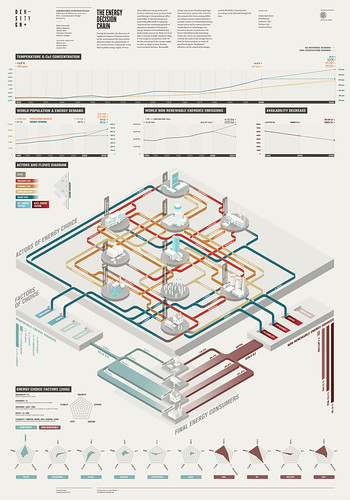Poster: The Energy Decision Chain
During last decades, the discovery of significant impacts of human activity on the environment has risen serious questions about the sustainability of our current society, in particular in the field of global energy supply. Proved that traditional energy production involves collateral waste products both contributing to the greenhouse effect responsible of climate change and presenting difficulties in dumping, considered the continuous growth of population, standard of living and energy demand and established that fossil energy sources are likely not to be able to provide enough energy for long, it is nowadays a compulsory order of the day reviewing of our energy supply in order to adapt to these forcing environmental features.
Renewable energy sources are therefore gaining a more and more central role, even if in this scenario the choice among different energy sources is determined by a complex system of relationships among several actors, which are disposed along a social hierarchy and led by various interests, mainly based on technologic and economic factors. In particular, the factors identified as discriminating within the choice are represented by the costs of the energy sources, their emissions in terms of greenhouse gases, the physical efficiency of the related technologies and the flexibility of production according to the demand through the time.
At the moment anyway fossil fuels are still massively preferred because of their unrivalled lower costs, higher efficiency and flexibility, while renewable sources are fighting their way thanks to their lighter environmental impact and economical incentives, especially in the field of providing energy to buildings.
Report: Every Light Has Its Shadow
Since the second step of our analysis aims to point out a particular controversy and map its deep complexity through an accurate cartography, we had to focus on a single aspect of the issue that could offer a heated debate to be investigated through digital online researches. According to our first results, we decided to delve deeper into the matter of renewable energy sources, definitely promising for the future, and we spotted solar photovoltaic energy for being a highly discussed but not inflated issue on a very recent subject fully available on the internet.
Because of its wideness the issue doesn’t appear as a definite controversy but rather as a problematic block of subjects. We thought that it would be more interesting to map all these focal points within the main discussion in order to underline their positioning along a leading thread, the life cycle of the panels. To sum up, we asked the web if photovoltaic power is considered more advantageous rather than disadvantageous.
First, we noticed a particular fragmentation among the protagonist websites, strongly lacking in authoritative sources and for this reason poor in relationships among themselves, so that we found much more fruitful a semantic analysis centred on contents. Then we gathered and filtered thousands of keywords in order to isolate the ones that could point to a controverted question or that could underline positive or negative aspects.
The confrontation with other energy sources emerges as the most discussed topic, followed by economical aspects and technical debates over solar energy and panels, while unexpectedly environment is only the last of the main themes. Further development of the analysis instead revealed that in general if there are online discussions over photovoltaic power they usually point out its advantageous aspects.
Video: Every Light Has Its Shadow
This third step of work exploits a simple eye-catching visual style and a clear narrative thread in order to make the complex results gotten through the research understandable to everyone: the protagonist and interlocutor is actually the private individual represented by the small house on the stage.
This last part summarizes the whole work of the project and tries to communicate the most important findings. The video in fact starts exploring the theme of energy supply, then focuses on renewable energy sources accessible to everyone and in the end explains seven crucial issues that emerged from the life cycle of the panels, emphasizing positive or negative sides of each one of them that everybody could bump into, while getting to grips with choosing photovoltaic power.
References
UN Intergovernmental Panel on Climate Change (IPCC)
UN Framework Convention on Climate Change (UNFCCC)
International Energy Agency (IEA)
Climate Change Adaptation Database
US Energy Information Administration (EIA)
Authors
Giulio Bertolotti
Elia Bozzato
Gabriele Calvi
Stefano Lari
Gianluca Rossi



